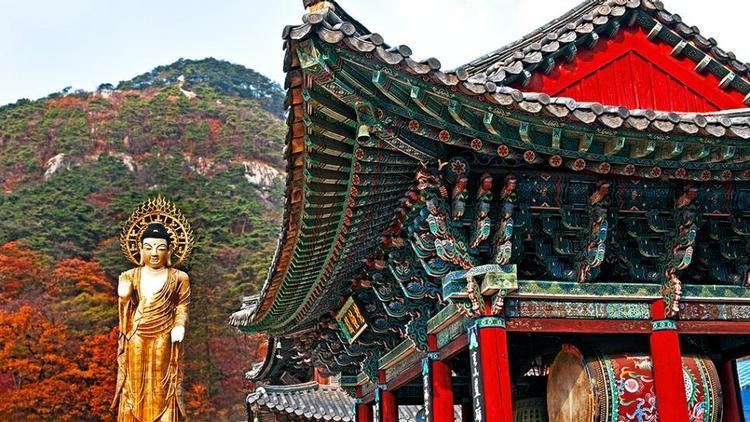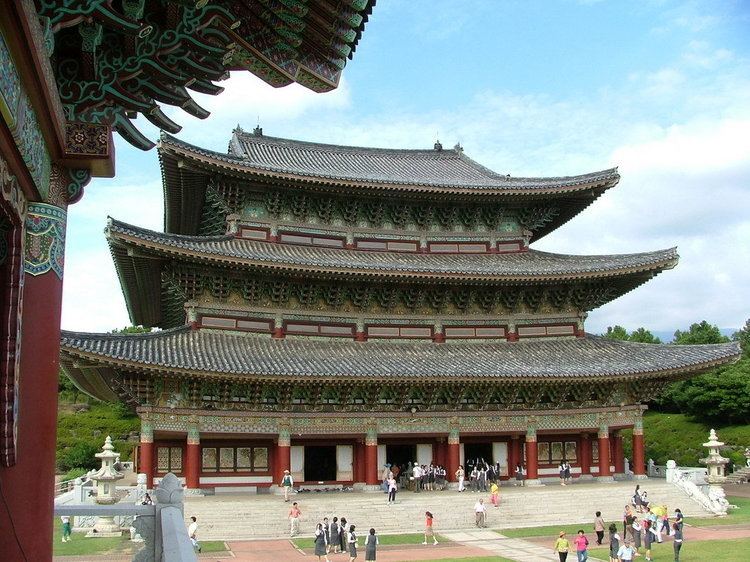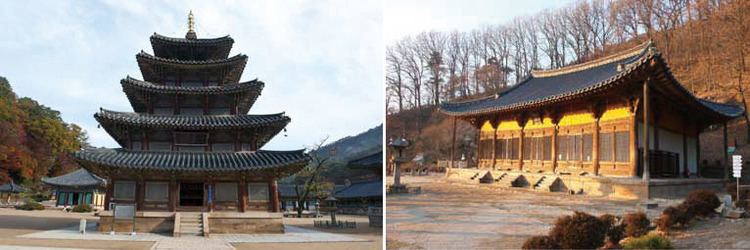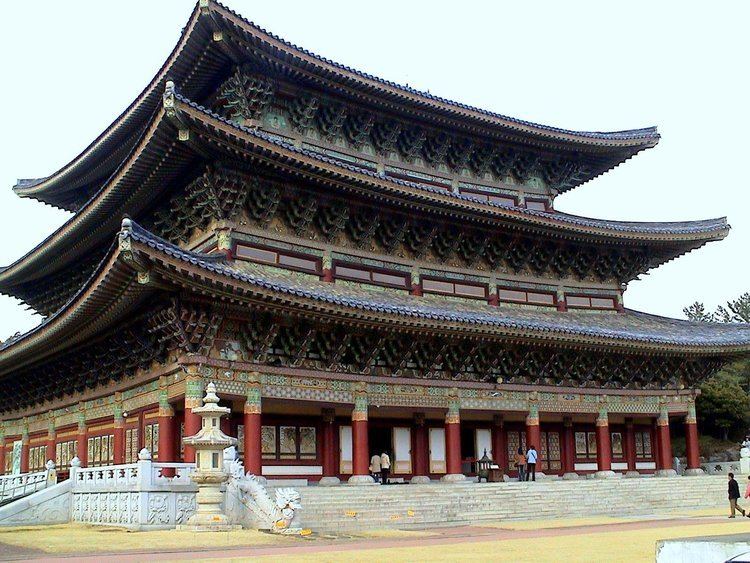 | ||
Buddhist temples are an important part of the Korean landscape. This article gives a brief overview of Korean Buddhism, then describes some of the more important temples in Korea. Most Korean temples have names ending in -sa (사, 寺), which means "temple" in Sino-Korean.
Contents

Temples, such as Sudeoksa offers visitors a "Temple Stay Program".
Background

A distinctive form of Buddhism evolved in Korea. This was facilitated by the geographical location and cultural conditions. Buddhism first arrived in Korea in 372 in the Goguryeo Kingdom. In 374 the influential Chinese monk Ado arrived in the kingdom and inspired the King Sosurim in the following year. The first two temples Seongmunsa and Ilbullansa were built in 375 on the order of the king. Buddhism soon became the national religion of the Goguryeo.

With the advent of Taoism in 624 the rulers began to suppress Buddhism and its importance quickly declined. The Baekje Kingdom, on the other hand, flourished under the influence of Buddhism. In 552 Buddhist scriptures were sent to Japan. This eventually led to the establishment of Buddhism in Japan.

In Silla Buddhism was important, too. It flourished during the reign of the King Jinheung (540 to 576). The Heungnyunsa temple was completed where any commoner could become a monk. The study of scriptures was greatly highlighted. For about 250 years Buddhism thrived in Unified Silla.

Buddhism was admired by Wang Geon, the founder of the Goryeo Dynasty. Throughout the country pagodas and other Buddhist structures were built. In the late Goryeo period Buddhism became linked with the corruption of the regime. A great number of monks were involved in politics. Bit by bit anti-Buddhist sentiments grew, leading to chaos which was ended by the establishment of the Joseon Dynasty. The king Taejo himself was a devout Buddhist, but the influence of monks was reduced. At times monks were treated as outcasts, but generally there was no hindrance to their practising. Buddhist heritage can be found all over the country in the form of temples, pagodas, sculptures, paintings, handicrafts and buildings.
Typical Layout
A typical Korean temple consists of the following elements:

- Iljumun (일주문, 一柱門) - One pillar gate found at the entrance to temple grounds
- Sacheonwangmun (사천왕문, 四天王門), also Cheonwangmun - Gate of the Four Heavenly Kings, to mark the entrance of the temple's boundaries
- Beopdang (법당, 法堂) - Dharma hall, used for lectures and sermons
- Monastic quarters
- Jonggo (종고, 鐘鼓) - bell tower
- Daeungjeon (대웅전, 大雄殿) - main shrine hall housing the temple's main Buddha images
- Pagoda
- Myeongbujeon (명부전, 冥府殿) - judgment hall, housing an image of the bodhisattva Ksitigarbha (지장, 地藏) and depictions of the Buddhist hell
- Nahanjeon (나한전, 羅漢殿) - Hall of the Arhats
- Sansingak (산신각, 山神閣) - an Shamanist shrine dedicated to the mountain god Sanshin (산신, 山神), who can be depicted as both a male or a female. Sometimes called chilseong-gak (칠성각, 七星閣) or samseong-gak (삼성각, 三星閣), this shrine is usually found behind the main shrine hall.
- Hermitage
North Korea
It is reported that many temples have been taken over by the state. Once the government controls these buildings, they are used mainly as museums of ancient Korean traditions. A few temples are still in use and they are considered national treasures[1]. Though few temples in large cities survived the US carpet bombings of the Korean War, many still survive in rural areas, and some of the more famous, large temples destroyed have since been rebuilt (such as the Ryongtong and Singye temples). All in all, there are 300 temples [2], but only in a few are religious services permitted.
In the list [3] that follows, temples marked with a "×" were destroyed during the Korean War or no longer exist for other reasons; temples marked with an "*" have been rebuilt.
South Korea
(a short text should be given here, describing the evolution of the temples from 1945 till now).
The following list is given by provinces (SK=South Korea, NK=North Korea), but it also can be sorted by Romanized or Korean names. Some Korean names, and founding dates are to be completed (the founding date applies to the location, even if none of the original structures survive). Recommended policy: no new entries, except from temples having their own English page in Wikipedia.
